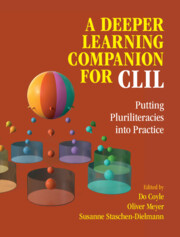Book contents
- A Deeper Learning Companion for CLIL
- A Deeper Learning Companion for CLIL
- Copyright page
- Contents
- Tables
- Figures
- Contributors
- Preface
- Part I Key Ideas and Principles of Pluriliteracies Teaching for Deeper Learning
- Part II Deeper Learning Episodes: First Steps towards Transforming Classrooms
- 5 Chemistry: Exploring Pluriliteracies through a Deeper Learning Episode on Redox Reactions
- 6 Physics: Exploring Pluriliteracies through a Deeper Learning Episode on Rainbows
- 7 Geography: Exploring Pluriliteracies through a Deeper Learning Episode on Global Warming
- 8 History: Exploring Pluriliteracies through a Deeper Learning Episode on the German Empire
- 9 Political Science: Exploring Pluriliteracies through a Deeper Learning Episode on Electronic Waste
- 10 Modern Languages: Exploring Pluriliteracies through a Deeper Learning Episode in French Literature with Younger Beginner Learners
- 11 Religious Education: Exploring Pluriliteracies through a Deeper Learning Episode on Modern-Day Prophets
- 12 Music: Exploring Pluriliteracies through a Deeper Learning Episode on ‘The Wellerman’
- 13 Deeper Learning Mathematics
- References
12 - Music: Exploring Pluriliteracies through a Deeper Learning Episode on ‘The Wellerman’
from Part II - Deeper Learning Episodes: First Steps towards Transforming Classrooms
Published online by Cambridge University Press: 04 February 2023
- A Deeper Learning Companion for CLIL
- A Deeper Learning Companion for CLIL
- Copyright page
- Contents
- Tables
- Figures
- Contributors
- Preface
- Part I Key Ideas and Principles of Pluriliteracies Teaching for Deeper Learning
- Part II Deeper Learning Episodes: First Steps towards Transforming Classrooms
- 5 Chemistry: Exploring Pluriliteracies through a Deeper Learning Episode on Redox Reactions
- 6 Physics: Exploring Pluriliteracies through a Deeper Learning Episode on Rainbows
- 7 Geography: Exploring Pluriliteracies through a Deeper Learning Episode on Global Warming
- 8 History: Exploring Pluriliteracies through a Deeper Learning Episode on the German Empire
- 9 Political Science: Exploring Pluriliteracies through a Deeper Learning Episode on Electronic Waste
- 10 Modern Languages: Exploring Pluriliteracies through a Deeper Learning Episode in French Literature with Younger Beginner Learners
- 11 Religious Education: Exploring Pluriliteracies through a Deeper Learning Episode on Modern-Day Prophets
- 12 Music: Exploring Pluriliteracies through a Deeper Learning Episode on ‘The Wellerman’
- 13 Deeper Learning Mathematics
- References
Summary
Conceptualising music education not only as ‘music-making’ but as ‘musical meaning-making‘, Valerie Krupp ’s learning episode provides a fascinating example of developing learner musical literacy skills – involving intra- and interpersonal negotiation and reflection and drawing on subject-specific knowledge, skills and processes. She argues that for learners to engage meaningfully in music analysis, recensions, aesthetic arguments and so on, they need to practise and use the language of musical genres and musical inquiry alongside language for critical and aesthetic evaluation. This, she proposes, promotes learner agency, encompassing musical literacies, competences and critical cultural consciousness. Situating the learning episode as praxial, student-relevant and real-world, it concerns the posting of a sea shanty, ‘The Wellerman’, on TikTok. Against all odds, the song ‘went viral‘, leading to ‘in the moment‘ global interest in sea shanties. Learners investigate why such a musical phenomenon took place. This opens up critical inquiry into the socio-cultural context of the shanty genre – classifying, analysing and critiquing musical and social media and analysing user comments. This example could be transferred to exploring other musical genres and interpretations.
Keywords
- Type
- Chapter
- Information
- A Deeper Learning Companion for CLILPutting Pluriliteracies into Practice, pp. 237 - 261Publisher: Cambridge University PressPrint publication year: 2023



